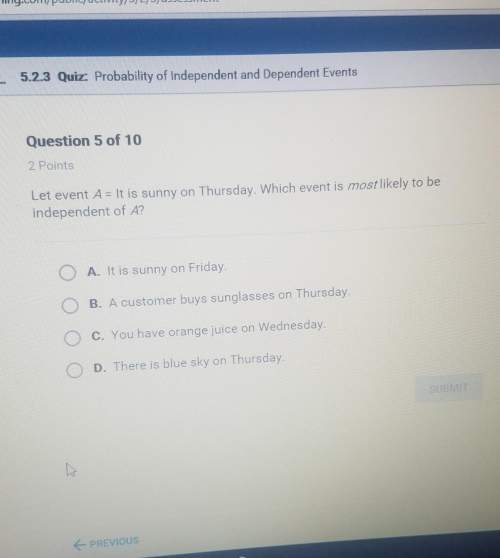
Mathematics, 01.11.2019 02:31, jedsgorditas
Day care centers expose children to a wider variety of germs than the children would be exposed to if they stayed at home more often. this has the obvious downside of more frequent colds and other illnesses, but it also serves to challenge the immune system of children at a critical stage in their development. a study by gilham et al. (2005) tested whether social activity outside the house in young children affected their probabilty of later developing the white blood cell disease acute lymphoblastic leukemia (all), the most common cancer of children. they compared 1272 children with acute lymphoblastic leukemia to 6238 children without acute lymphoblastic leukemia. of the acute lymphoblastic leukemia kids, 1020 had significant social activity outside the home (including day care) when younger. of the kids without acute lymphoblastic leukemia, 5343 had significant social activity outside the home. the rest of the children in both groups lacked regular contact with children who were not in their immediate surroundings.
a.) is this an experimental or observational study?
b.) what are the proportions of children with significant social activity in children with and without acute lymphoblastic leukemia?
c.) what is the odds ratio for acute lymphoblastic leukemia, comparing the groups with and without significant social activity?
d.) what is the 95% confidence interval for this odds ratio?
e.) does this confidence interval indicate that the amount of social activity is associated with acute lymphoblastic leukemia? if so, did the children with more social activity have a higher or lower occurence of acute lymphoblastic leukemia?
f.) the researchers interpreted their study results in terms of the differing immune system exposure of the children, but gave several alternative explanations for the pattern. can you think of any possible cofounding variables?

Answers: 2
Other questions on the subject: Mathematics

Mathematics, 21.06.2019 17:30, emmilicious
Me with this one question, and i'll upvote the brainliest answer
Answers: 2

Mathematics, 21.06.2019 20:30, cogger9348
3.17 scores on stats final. below are final exam scores of 20 introductory statistics students. 1 2 3 4 5 6 7 8 9 10 11 12 13 14 15 16 17 18 19 20 57, 66, 69, 71, 72, 73, 74, 77, 78, 78, 79, 79, 81, 81, 82, 83, 83, 88, 89, 94 (a) the mean score is 77.7 points. with a standard deviation of 8.44 points. use this information to determine if the scores approximately follow the 68-95-99.7% rule. (b) do these data appear to follow a normal distribution? explain your reasoning using the graphs provided below.
Answers: 1

Mathematics, 21.06.2019 20:30, brookieharrisop5n7us
What is the volume of the cone to the nearest cubic millimeter? (use π = 3.14) a) 46 mm3 b) 128 mm3 c) 183 mm3 d) 275 mm3 diameter = 5 mm height = 7 mm how do you do this problem step by step?
Answers: 1

Mathematics, 21.06.2019 23:30, hntnhtthnyt
Kerion has a beaded necklace business. she can make 12 necklaces is 2 hours. how long will it take her to make 9 necklaces?
Answers: 1
Do you know the correct answer?
Day care centers expose children to a wider variety of germs than the children would be exposed to i...
Questions in other subjects:


Engineering, 11.07.2019 01:20



Engineering, 11.07.2019 01:20





History, 11.07.2019 01:20







